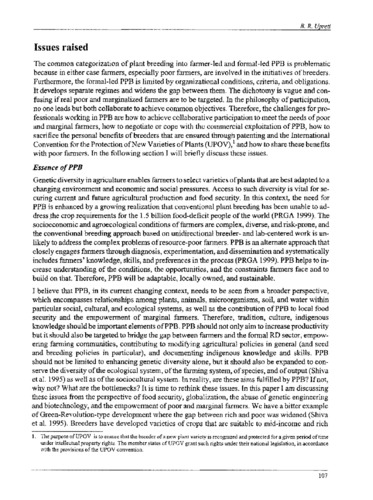Recent progress in cassava varietal improvement in Indonesia
In Indonesia, cassava is used mostly for human consumption, while a smaller part is used for animal feed and as raw material in industry. This crop is cultivated in almost all provinces of Indonesia. However, because the amount of rainfall among the regions varies and is not evenly distributed, some regions have a wet climate while others have a dry climate. The type of climate affects the suitability of a particular variety and its productivity.
The area planted to cassava in Indonesia is about 1.3 million ha producing approximately 16.3 million tons fresh cassava roots; this means that the average production per hectare is still low at about 12.2 t/ha. This low yield is due to the use of local varieties, traditional cropping patterns and simple cultural practices. According to the government, cassava production is projected to increase to about 16.5 million tons in the year 2000. This production can be achieved by intensifying the cultural practices as well as by the use of higher yielding cassava varieties, either sweet or bitter ones.
Up to now, a very limited number of high yielding varieties have been released, i.e. only ten new varieties from 1969 to 1990 for all cassava areas in Indonesia, compared to 74 rice, 28 maize, 25 soybean, and 5 sweet potato varieties. Some new cassava varieties were released, such as Adira 1 (sweet) and Adira 2 (bitter) in 1978, and Adira 4 (bitter) in 1986. In 1993 MARIF (Malang Research Institute for Food Crops) released two new varieties named Malang 1 (CM4049-2) and Malang 2 (CM4031-10).
Since 1984, Brawijaya University, in cooperation with CIAT, has been conducting cassava breeding. From F, cassava seed that had been provided, four promising clones were selected, i.e. UB 1/2 (CM3962-2), UB 15/10 (CM3380-10), UB 881-5 (SM881-5) and UB477-2 (SM477-2). Multi-location trials have been conducted several times with these clones, especially in East Java. Concerning governmental regulations about the realease of new varieties, one must conduct multilocational trials of these promising lines or clones in at least five provinces. In 1995, those promising cassava clones were planted in East Java, Central Java, Lampung, North Sulawesi and Lombok. The result of these trials could suggest the release of these lines as new cassava varieties. From the results it was concluded that clones UB 1/2 and UB 15/10 (both bitter) are more suitable for regions with a wet climate, while clones UB 881-5 (bitter) and UB 477-2 (sweet) are more suitable for those with a dry climate.

